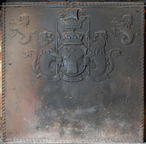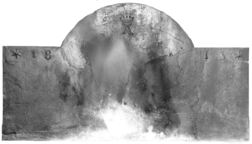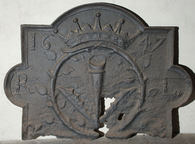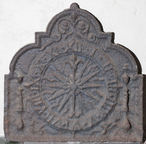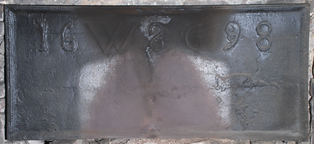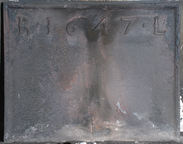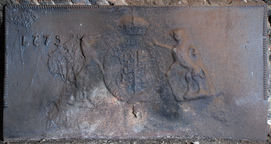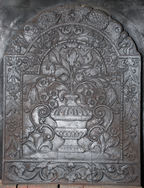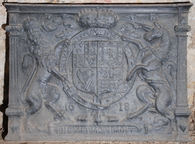-
907
Description: Rectangular; simulated twisted rope edging; top centre, shield, baron's coronet, supporters and crest; in each top corner, heraldic badge - a Sea Lion holding an anchor.
Notes: The arms are of Sir Hudson Ewbanke Kearley, Bt., 1st Baron Devonport (1856-1934); created 1910, he was elevated to Viscount in 1917, thus the fireback would have been cast between 1910 and 1917. Blazon: Azure in chief two Mitres Argent garnished Or and in base a Square Tower of the second, a baronet's badge in chief; Supporters: On either side a Sea Lion Argent crined finned and tufted Or each gorged with a Collar Gules charged with three Roses of the second and each supporting a Spear erect proper; Crest: An Ancient Ship Or the Mainsail Azure charged with a Sea Lion of the first; Motto: Fit Via Vi (The way is made through strength). A version with the same arms and badges has an arched rectangular shape and plain edging.
Inscription: FIT VIA VI
Arms: Hudson Ewbanke Kearley, 1st Baron Devonport (later 1st Viscount)
- Decoration tags:
- rectangular (shape)
- simulated rope (edging)
- carved stamps
- heraldic
- armorial
Manufactured: in the early-20th century in England.
Current location: in private hands, Penhurst, East Sussex, England.
- Attached to series:
- Personal armorial firebacks
- Devonport arms series
-
508
Description: Arched rectangular shape; no edging; top centre, crowned capital ‘A’; date divided at top corners of plate; single six-pointed star outside date.
Notes: Earl’s coronet denotes the Earl of Ashburnham, furnace owner; the furnace was blown out for the last time in late February 1813, this fireback being reputedly the last casting from a Wealden furnace. One of a small series of firebacks cast in the early-19th century for farms on the Ashburnham estate.
Inscription: * 18 A 13 *
- Decoration tags:
- rectangular with round arch (shape)
- none (edging)
- carved stamps
- individual letters
- individual numbers
- text
- objects
Manufactured: in 1813 at Ashburnham Furnace in the Weald area of England.
Current location: in private hands, Penhurst, East Sussex, England.
- Attached to series:
- Ashburnham late series
- Date & initials firebacks
-
511
Description: Rectangular with semi-circular protrusions on the top and sides; cavetto edging; a pheon (a downward-pointing arrow head barbed on the inner edge), within a wreath, an earl’s coronet above; the date on either side of the coronet; the initials on left and right sides; a fleur de lys in each bottom corner.
Notes: The wreathed pheon and coronet are cast from a different pattern to the 1626 and 1630 plates.
Copies of this fireback are known.
Inscription: 16 47 / R L
- Decoration tags:
- rectangular with round arch (shape)
- cavetto (edging)
- whole carved pattern
- planklines
- heraldic
- text
Manufactured: in 1647 possibly at Robertsbridge Furnace, Salehurst in the Weald area of England.
Current location: Penshurst Place, Penshurst, Kent, England.
- Attached to series:
- Earl of Leicester series
- Personal firebacks
-
512
Description: Double arched rectangular shaped; ovolo edging; central clock dial with Roman numerals separated by stops, sunburst inside, single hand with fleur de lys pointer; teardrop weights, with finials above, suspended from each side; symmetrical tendrils above; date split below dial.
Notes: One of the ‘hooked 1’ series of firebacks; two versions exist of this fireback, the other without finials above the suspended weights.
Copies of this fireback are known.
Inscription: I · II · III · IIII · V · VI · VII · VIII · IX · X · XI · XII / 16 5 [..]
- Decoration tags:
- rectangular with round arch (shape)
- ovolo (edging)
- whole carved pattern
- pictorial
- text
- objects
Manufactured: in 1652 possibly at Brede Furnace in the Weald area of England.
Current location: Penshurst Place, Penshurst, Kent, England.
Citation: Gardner, J. S., 1898, 'Iron Casting in the Weald', Archaeologia, 56, 1, pp. 133-164.
- Attached to series:
- Hooked '1' series
- Brede group
-
513
Description: Rectangular; complex (astragal & fillet/cavetto) moulded edging; initials across top, between split date.
Inscription: 16 WSG 98 [‘S’ reversed]
- Decoration tags:
- rectangular (shape)
- astragal and fillet/cavetto (edging)
- individual letters
- individual numbers
- planklines
- text
Manufactured: in 1698 in the Weald area of England.
Current location: Penshurst Place, Penshurst, Kent, England.
- Attached to series:
- Date & initials firebacks
-
514
Description: Rectangular; ovolo-moulded edging (top and sides); inscription along top of plate.
Notes: The initials may relate to Robert, 2nd Earl of Leicester.
Inscription: R · 1647 · L
- Decoration tags:
- rectangular (shape)
- ovolo (edging)
- individual letters
- individual numbers
- text
Manufactured: in 1647 in the Weald area of England.
Current location: Penshurst Place, Penshurst, Kent, England.
- Attached to series:
- Date & initials firebacks
-
515
Description: Rectangular; rope edging (top & sides); in centre, Tudor shield, garter, crown and supporters (greyhound and lion); date top left.
Notes: The armorial achievement is seen on other firebacks and was formed from four separate stamps (one example has the shield and garter inverted); the supporters are consistent with the date; the style of the numerals is uncharacteristic of the period. The same date in identical form is on a similar fireback at Groombridge Place, Speldhurst, Kent.
Inscription: 1579 / HONE SOVT qVEY MAL Y PENSE
Arms: Tudor royal
- Decoration tags:
- rectangular (shape)
- rope (edging)
- carved stamps
- date stamp
- armorial
- royal
- text
Manufactured: in 1579 in the Weald area of England.
Current location: Penshurst Place, Penshurst, Kent, England.
- Attached to series:
- Pounsley series
- Tudor royal armorial firebacks
- Tudor redated series
-
516
Description: Arched rectangular central panel with bead-and-pellet edging; on a ground between two plants, a gadrooned flower vase with two, scrolled handles, tulips and other flowers issuing from the narrow neck; arched rectangular border with fillet edging; mirrored descending flower swags; along a rectangular bottom panel with fillet edging a symmetrical arrangement of swirled foliage; on top, two mirrored sea serpents.
Notes: The presence of tulips suggest a Dutch origin for the pattern of this fireback, although the presence of several examples in England suggest that it was produced here rather than on the Continent.
Copies of this fireback are known.
- Decoration tags:
- 'Dutch' (shape)
- fillet (edging)
- whole carved pattern
- planklines
- pictorial
- plants
- objects
Manufactured: in the late-17th century in England.
Current location: Penshurst Place, Penshurst, Kent, England.
- Attached to series:
- Flower Vase 'Dutch' types
- British 'Dutch' style firebacks
-
517
Description: Rectangular; ogee within broad fillet moulded edging; top centre, date between split initials, with small diamonds between date and initials and outside initials.
Inscription: T 1665 S
- Decoration tags:
- rectangular (shape)
- fillet and ogee (edging)
- text
Manufactured: in 1665 in the Weald area of England.
Current location: Penshurst Place, Penshurst, Kent, England.
- Attached to series:
- Date & initials firebacks
-
519
Description: Rectangular; Ionic pilasters at sides, architrave on top; English Stuart royal shield, garter, crown, motto and supporters; date below and either side of garter.
Notes: One of several firebacks, all of the same date, but varying in size, framing style and moulding; all have stylistic features in common and will have been the work of the same pattern maker, who was also responsible for carving royal coats of arms in three West Country churches. A plaster cast of a fireback of this design is displayed as the royal arms in St George's church, near Abergele in north Wales.
Copies of this fireback are known.
Inscription: HONI SOIT QVI MAL Y PENSE / 16 18 / DIEV ET MON DROIT
Arms: English Stuart royal (James I)
- Decoration tags:
- rectangular (shape)
- complex individual (edging)
- whole carved pattern
- armorial
- royal
- text
Manufactured: in 1618 possibly in the Forest of Dean area of England.
Current location: Penshurst Place, Penshurst, Kent, England.
